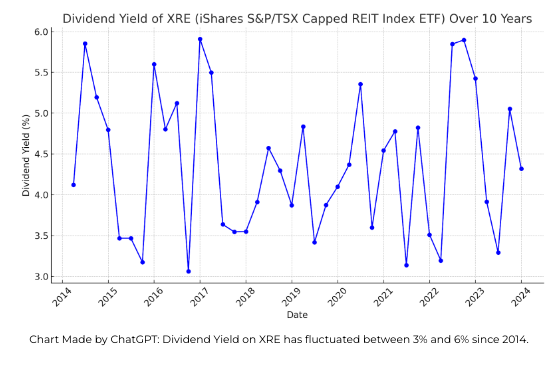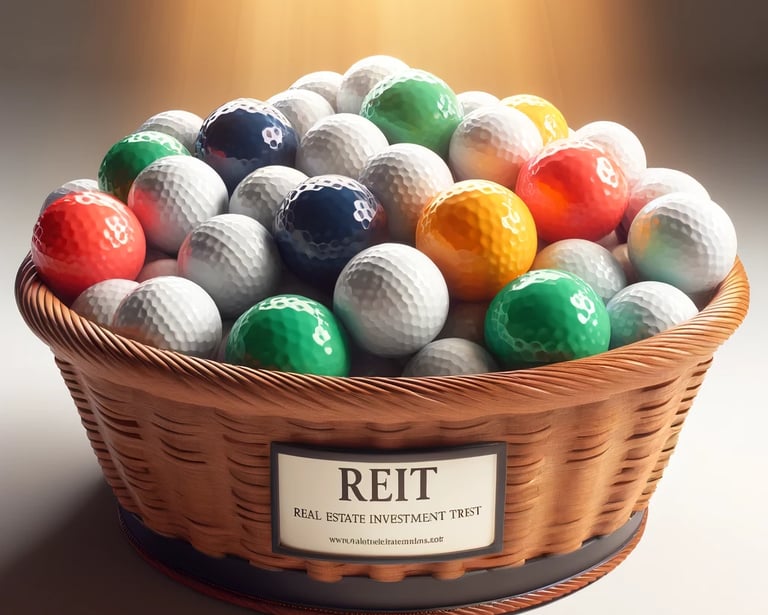How to Invest in Real Estate Without Buying Property?
Want to learn how to invest in real estate without buying property? Learn about the benefits, risks, and small investment demands of REITS.
INVESTINGREITSREAL ESTATE INVESTMENT TRUSTSCANADIAN HOUSING MARKET
3/8/202515 min read
Introduction
We believe there are two types of people when it comes to real estate investment.
The first group wants to buy a home for themselves and their family.
The second group seeks to invest in property to generate income—whether through rental payments or capital appreciation by selling the property for a profit.
Depending on your financial or personal situation you may want a mix of both. This could be through the purchase of a secondary property, or a separate unit in your primary property for tenants. No matter which category you fall into, the majority of Canadian's aspire to own real estate.
Current Housing Situation
One of the most debated topics in Canada is housing affordability. Many young Canadians, in particular, feel that home ownership is slipping out of reach. The numbers support the claim that they may just be right:
In December 2006 the average Canadian home sold for $286,700. By December 2024 that figure had reached $705,600 [1]. That works out to a 146.1% increase in 18 years, or 8.1% per year. This is just an average though, and many markets have seen significantly larger increases over this time period.
In December 2006 the average home in Fraser Valley BC was $363,100 [1]. As of December 2024 that price was $965,000 [1]. That is a 165.8% increase in 18 years, or 9.2% per year.
Also, during short periods of time (< 5 years) some markets seen price growth of greater then 10% annually.
Although these figures are already very troublesome. The impact on young Canadian's is made worse when compared to income data:
Over the 16 year period from 2006-2022 the real median before tax household income increased from $76,900 to $90,200. That is a 17.3% increase, or a 1.08% increase annually [2]. (Note: We couldn’t obtain data more recent than 2022)
Based on this rough data the cost of housing is outpacing wages by ~7% annually. This doesn’t even factor in recent mortgage rate increases, rising utility costs, food price increases, and the list goes on.
A 2023 report from RBC called “Housing Trends and Affordability” showed the percentage of household income that would be needed to cover the costs of ownership in major cities across Canada. On average in Canada it was 62.5% of yearly income. Meanwhile in places like Vancouver it was 102.6%. The lowest was Calgary at 47.6% [3].
Provided you do decide to purchase the “Average Canadian Home” a 20% down payment would amount to $144,960.
While solving this affordability crisis is complex, there are ways you can gain exposure to the real estate market without a large upfront investment. One such way is through purchasing shares in Real Estate Investment Trusts (REITs).
What Are REITs?
Think of REIT’s as a large corporation that purchases real estate properties, or acquires other companies that own real estate. The structure isn’t actually a corporation but rather a Trust, which we will explain why later in this article. The REIT, like a stock, will issue shares to the public to share in ownership. This benefits the REIT as it enables them to acquire more properties through funding from the general population. But it also enables you or I to acquire partial ownership of these properties at a fraction of the actual cost.
Let’s use an analogy to further understand. Think about a REIT as a basket of golf balls. The REIT is the basket that holds the balls. The balls that fill up the basket are the individual real estate assets.
The next layer of complexity would be to picture the same golf ball basket, however, there are various colours of balls. In this case:
The REIT is the basket
Each ball represents a different property
Red golf balls for commercial properties (ex. shopping centers)
Green balls for residential real estate (ex. apartments)
Yellow balls for industrial properties (ex. data centers or warehouses).
Some REITS may only focus on one specific type of property, while others may hold a variety of different categories.
The properties within a REIT are managed by professionals, and the income they generate—whether through rent or other means—is distributed to shareholders, like you, in the form of dividends or distributions.
Why Are REITs Held in a Trust?
A question many investors have is: why are REITs structured as trusts rather than corporations?
When you invest in companies like Apple or Microsoft, you're investing in corporations. This structure provides both tax, and liability benefits. However, it can reduce the profits available to distribute to shareholders.
Example. If Apple decides to pay a dividend, it does so from its net profit (ie. Income after taxes). So after Apple earns revenue from selling its products, and subtracts its expenses, the remaining gross profit is taxed at the corporate level. Then, the company distributes dividends from the after-tax profits. That’s the first layer of taxation.
Meanwhile, if you or I receive these dividends in a taxable account, we would then need to report them to the CRA, leading to a second layer of taxation.
In contrast, REIT’s use what’s called a "flow-through" structure. As long as a REIT distributes at least 90% of its profits to shareholders, it avoids corporate taxation (ie. The First Layer). You as the shareholder will only be taxed when you receive the distributions. Meanwhile, if the REIT is held in a tax-sheltered account (like a TFSA or RRSP), you can avoid these taxes entirely or defer them to a later date [4].
Types of REITs
There are two main types of REITs: public and private
Public REITs
These REIT’s are traded on the stock exchange, and you can buy them through your brokerage account. Some benefits include:
Low cost of entry: You don’t need a lot of capital to start. For example, XRE, a popular Canadian REIT, currently trades at around $14.91 per share.
High liquidity: If you need cash or want to change your investments, you can sell your REIT shares quickly on the open market.
Tax advantages: You can hold public REITs in tax-sheltered accounts like a TFSA, RRSP, or FHSA. This helps reduce the tax burden of your distributions.
However, public REITs are subject to market volatility. Like stocks, their prices can fluctuate significantly in the short term. Even if the underlying real estate assets don’t change in value as quickly.
Private REITs
These REITs are not traded on the stock exchange. You generally need to purchase them through a financial advisor, or directly from the management company. Some benefits include:
Less Volatility: The returns generally are more stable because they are not traded on the open market, and there may be a required minimum holding period.
Potentially Higher Returns: Access to properties with greater risk but higher potential upside.
However, private REITs come with higher initial costs, greater risk due to less regulatory oversight, and they’re harder to access. Additionally, the taxation is much more complicated and you may not be able to hold them in tax-sheltered accounts.
Why Invest in REITs?
There are some compelling reasons for young Canadians to consider REITs for their portfolio:
Minimal Cost of Entry
You can start investing in real estate with small amounts of capital.
Unlike purchasing a property, which requires a significant down payment, REIT shares can be bought for as little as a few dollars.
Diversification
REITs give you exposure to different sectors of the real estate market, from residential and commercial properties to industrial and retail.
Moreover, REITs may not always move in tandem with the stock market, offering potential for diversification benefits.
Professional Management
By investing in REITs, you're essentially outsourcing the complexities of managing real estate to professionals. These teams handle everything from acquisition to maintenance and sales, giving you peace of mind.
Income Generation
REITs are known for their strong distribution payouts, making them an attractive source of passive income.
This is particularly valuable during retirement when income-generating assets like dividend stocks or bonds become essential.
Potential Risks/Downsides of Investing in REITS?
The following are some risks or potential downsides we see with investing in REITs:
Sector Specific Risk
By Investing in the real estate market only you expose yourself to sector specific risk. This means that if something were to happen that would materially change housing or rental costs on the downside you could be significantly effected (ie. 2008 housing crisis)
However, provided that you diversify and don’t hold 100% of your assets within the real estate market this risk is minimized.
Sub-Sector Specific Risk
Some REITs are concentrated to specific sectors of the real estate market. In some cases those sectors could be more impacted by economic forces then other sectors.
For example: During the Covid-19 pandemic commercial real estate was significantly impacted because office workers switched to remote work. Meanwhile, residential real estate didn’t experience as significant of a disruption.
Tax Implications- Distribution vs Dividends
This is more of a downside then a risk. People often mistakenly think that the income paid out by REITS is dividends. Actually, it is paid out in the form of a distributions. This has specific tax implications particularly if you are holding the REITS in a taxable account. This means that the income produced from REITS may not be eligible for dividend tax credits and actually could be taxed like interest income at your marginal tax rate. Of course, if they are held in your tax-sheltered accounts such as TFSA, RRSP, or FHSA there is no taxation at the time of distribution.
Related Posts
[FHSA Canada Guide: How It Works for First-Time Home Buyers]
[How Does the Home Buyer’s Plan & Lifelong Learning Plan Work in Canada? (RRSP Guide)]
Disclaimer: The information discussed in this blog is not financial advice, and is meant for educational purposes only. Please consult a personal financial expert before making any financial decisions.
Citations
Canada Mortgage and Housing Corporation. (n.d.). Real median total household income before taxes. CMHC-SCHL. Retrieved February 7, 2025, from https://www.cmhc-schl.gc.ca/professionals/housing-markets-data-and-research/housing-data/data-tables/household-characteristics/real-median-total-household-income-before-taxes
Canadian Real Estate Association. (n.d.). Housing market stats. CREA. Retrieved February 7, 2025, from https://stats.crea.ca/en-CA/
Royal Bank of Canada. (2023, December). Housing trends and affordability. RBC Thought Leadership. Retrieved from https://thoughtleadership.rbc.com/wp-content/uploads/RBC-Housing-Trends-and-Affordability-December-2023.pdf
Nicola Wealth. (2022, March 30). The Liberals’ plan to review tax treatment of REITs: Will this help renters? Retrieved from https://nicolawealth.com/insights/the-liberals-plan-to-review-tax-treatment-of-reits-will-this-help-renters
OpenAI. (2025). Dividend Yield of XRE (iShares S&P/TSX Capped REIT Index ETF) Over 10 Years. [AI-generated graph]. ChatGPT.https://chat.openai.com/
ChatGPT. (2025). A basket filled with only white golf balls, representing a simple investment structure [AI-generated image]. OpenAI.
ChatGPT. (2025). A basket filled with golf balls of different colors, representing various types of real estate investments [AI-generated image]. OpenAI.
Beyond MD. (2021, November 16). Real Estate Investment Trusts [Podcast]. Beyond MD Podcast.
BlackRock. (n.d.). iShares S&P/TSX Capped REIT Index ETF. BlackRock. Retrieved February 6, 2025, from https://www.blackrock.com/ca/investors/en/products/239843/ishares-sptsx-capped-reit-index-etf






Introduction
We believe there are two types of people when it comes to real estate investment.
The first group wants to buy a home for themselves and their family.
The second group seeks to invest in property to generate income—whether through rental payments or capital appreciation by selling the property for a profit.
Depending on your financial or personal situation you may want a mix of both. This could be through the purchase of a secondary property, or a separate unit in your primary property for tenants. No matter which category you fall into, the majority of Canadian's aspire to own real estate.
Current Housing Situation
One of the most debated topics in Canada is housing affordability. Many young Canadians, in particular, feel that home ownership is slipping out of reach. The numbers support the claim that they may just be right:
In December 2006 the average Canadian home sold for $286,700. By December 2024 that figure had reached $705,600 [1]. That works out to a 146.1% increase in 18 years, or 8.1% per year. This is just an average though, and many markets have seen significantly larger increases over this time period.
In December 2006 the average home in Fraser Valley BC was $363,100 [1]. As of December 2024 that price was $965,000 [1]. That is a 165.8% increase in 18 years, or 9.2% per year.
Also, during short periods of time (< 5 years) some markets seen price growth of greater then 10% annually.
Although these figures are already very troublesome. The impact on young Canadian's is made worse when compared to income data:
Over the 16 year period from 2006-2022 the real median before tax household income increased from $76,900 to $90,200. That is a 17.3% increase, or a 1.08% increase annually [2]. (Note: We couldn’t obtain data more recent than 2022)
Based on this rough data the cost of housing is outpacing wages by ~7% annually. This doesn’t even factor in recent mortgage rate increases, rising utility costs, food price increases, and the list goes on.
A 2023 report from RBC called “Housing Trends and Affordability” showed the percentage of household income that would be needed to cover the costs of ownership in major cities across Canada. On average in Canada it was 62.5% of yearly income. Meanwhile in places like Vancouver it was 102.6%. The lowest was Calgary at 47.6% [3].
Provided you do decide to purchase the “Average Canadian Home” a 20% down payment would amount to $144,960.
While solving this affordability crisis is complex, there are ways you can gain exposure to the real estate market without a large upfront investment. One such way is through purchasing shares in Real Estate Investment Trusts (REITs).
What Are REITs?
Think of REIT’s as a large corporation that purchases real estate properties, or acquires other companies that own real estate. The structure isn’t actually a corporation but rather a Trust, which we will explain why later in this article. The REIT, like a stock, will issue shares to the public to share in ownership. This benefits the REIT as it enables them to acquire more properties through funding from the general population. But it also enables you or I to acquire partial ownership of these properties at a fraction of the actual cost.
Let’s use an analogy to further understand. Think about a REIT as a basket of golf balls. The REIT is the basket that holds the balls. The balls that fill up the basket are the individual real estate assets.
The next layer of complexity would be to picture the same golf ball basket, however, there are various colours of balls. In this case:
The REIT is the basket
Each ball represents a different property
Red golf balls for commercial properties (ex. shopping centers)
Green balls for residential real estate (ex. apartments)
Yellow balls for industrial properties (ex. data centers or warehouses).
Some REITS may only focus on one specific type of property, while others may hold a variety of different categories.
The properties within a REIT are managed by professionals, and the income they generate—whether through rent or other means—is distributed to shareholders, like you, in the form of dividends or distributions.
Why Are REITs Held in a Trust?
A question many investors have is: why are REITs structured as trusts rather than corporations?
When you invest in companies like Apple or Microsoft, you're investing in corporations. This structure provides both tax, and liability benefits. However, it can reduce the profits available to distribute to shareholders.
Example. If Apple decides to pay a dividend, it does so from its net profit (ie. Income after taxes). So after Apple earns revenue from selling its products, and subtracts its expenses, the remaining gross profit is taxed at the corporate level. Then, the company distributes dividends from the after-tax profits. That’s the first layer of taxation.
Meanwhile, if you or I receive these dividends in a taxable account, we would then need to report them to the CRA, leading to a second layer of taxation.
In contrast, REIT’s use what’s called a "flow-through" structure. As long as a REIT distributes at least 90% of its profits to shareholders, it avoids corporate taxation (ie. The First Layer). You as the shareholder will only be taxed when you receive the distributions. Meanwhile, if the REIT is held in a tax-sheltered account (like a TFSA or RRSP), you can avoid these taxes entirely or defer them to a later date [4].
Types of REITs
There are two main types of REITs: public and private
Public REITs
These REIT’s are traded on the stock exchange, and you can buy them through your brokerage account. Some benefits include:
Low cost of entry: You don’t need a lot of capital to start. For example, XRE, a popular Canadian REIT, currently trades at around $14.91 per share.
High liquidity: If you need cash or want to change your investments, you can sell your REIT shares quickly on the open market.
Tax advantages: You can hold public REITs in tax-sheltered accounts like a TFSA, RRSP, or FHSA. This helps reduce the tax burden of your distributions.
However, public REITs are subject to market volatility. Like stocks, their prices can fluctuate significantly in the short term. Even if the underlying real estate assets don’t change in value as quickly.
Private REITs
These REITs are not traded on the stock exchange. You generally need to purchase them through a financial advisor, or directly from the management company. Some benefits include:
Less Volatility: The returns generally are more stable because they are not traded on the open market, and there may be a required minimum holding period.
Potentially Higher Returns: Access to properties with greater risk but higher potential upside.
However, private REITs come with higher initial costs, greater risk due to less regulatory oversight, and they’re harder to access. Additionally, the taxation is much more complicated and you may not be able to hold them in tax-sheltered accounts.
Why Invest in REITs?
There are some compelling reasons for young Canadians to consider REITs for their portfolio:
Minimal Cost of Entry
You can start investing in real estate with small amounts of capital.
Unlike purchasing a property, which requires a significant down payment, REIT shares can be bought for as little as a few dollars.
Diversification
REITs give you exposure to different sectors of the real estate market, from residential and commercial properties to industrial and retail.
Moreover, REITs may not always move in tandem with the stock market, offering potential for diversification benefits.
Professional Management
By investing in REITs, you're essentially outsourcing the complexities of managing real estate to professionals. These teams handle everything from acquisition to maintenance and sales, giving you peace of mind.
Income Generation
REITs are known for their strong distribution payouts, making them an attractive source of passive income.
This is particularly valuable during retirement when income-generating assets like dividend stocks or bonds become essential.
Potential Risks/Downsides of Investing in REITS?
The following are some risks or potential downsides we see with investing in REITs:
Sector Specific Risk
By Investing in the real estate market only you expose yourself to sector specific risk. This means that if something were to happen that would materially change housing or rental costs on the downside you could be significantly effected (ie. 2008 housing crisis)
However, provided that you diversify and don’t hold 100% of your assets within the real estate market this risk is minimized.
Sub-Sector Specific Risk
Some REITs are concentrated to specific sectors of the real estate market. In some cases those sectors could be more impacted by economic forces then other sectors.
For example: During the Covid-19 pandemic commercial real estate was significantly impacted because office workers switched to remote work. Meanwhile, residential real estate didn’t experience as significant of a disruption.
Tax Implications- Distribution vs Dividends
This is more of a downside then a risk. People often mistakenly think that the income paid out by REITS is dividends. Actually, it is paid out in the form of a distributions. This has specific tax implications particularly if you are holding the REITS in a taxable account. This means that the income produced from REITS may not be eligible for dividend tax credits and actually could be taxed like interest income at your marginal tax rate. Of course, if they are held in your tax-sheltered accounts such as TFSA, RRSP, or FHSA there is no taxation at the time of distribution.
Related Posts
[FHSA Canada Guide: How It Works for First-Time Home Buyers]
[How Does the Home Buyer’s Plan & Lifelong Learning Plan Work in Canada? (RRSP Guide)]
Disclaimer: The information discussed in this blog is not financial advice, and is meant for educational purposes only. Please consult a personal financial expert before making any financial decisions
Citations
Canada Mortgage and Housing Corporation. (n.d.). Real median total household income before taxes. CMHC-SCHL. Retrieved February 7, 2025, from https://www.cmhc-schl.gc.ca/professionals/housing-markets-data-and-research/housing-data/data-tables/household-characteristics/real-median-total-household-income-before-taxes
Canadian Real Estate Association. (n.d.). Housing market stats. CREA. Retrieved February 7, 2025, from https://stats.crea.ca/en-CA/
Royal Bank of Canada. (2023, December). Housing trends and affordability. RBC Thought Leadership. Retrieved from https://thoughtleadership.rbc.com/wp-content/uploads/RBC-Housing-Trends-and-Affordability-December-2023.pdf
Nicola Wealth. (2022, March 30). The Liberals’ plan to review tax treatment of REITs: Will this help renters? Retrieved from https://nicolawealth.com/insights/the-liberals-plan-to-review-tax-treatment-of-reits-will-this-help-renters
OpenAI. (2025). Dividend Yield of XRE (iShares S&P/TSX Capped REIT Index ETF) Over 10 Years. [AI-generated graph]. ChatGPT.https://chat.openai.com/
ChatGPT. (2025). A basket filled with only white golf balls, representing a simple investment structure [AI-generated image]. OpenAI.
ChatGPT. (2025). A basket filled with golf balls of different colors, representing various types of real estate investments [AI-generated image]. OpenAI.
Beyond MD. (2021, November 16). Real Estate Investment Trusts [Podcast]. Beyond MD Podcast.
BlackRock. (n.d.). iShares S&P/TSX Capped REIT Index ETF. BlackRock. Retrieved February 6, 2025, from https://www.blackrock.com/ca/investors/en/products/239843/ishares-sptsx-capped-reit-index-etf






